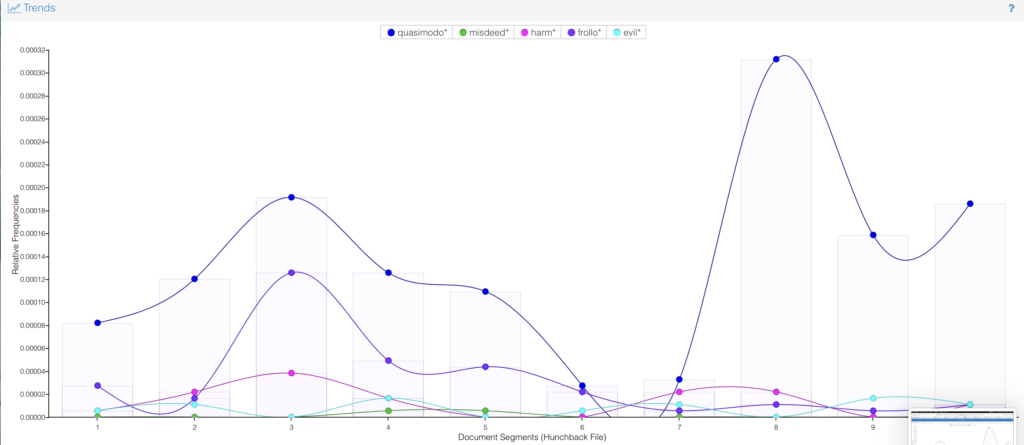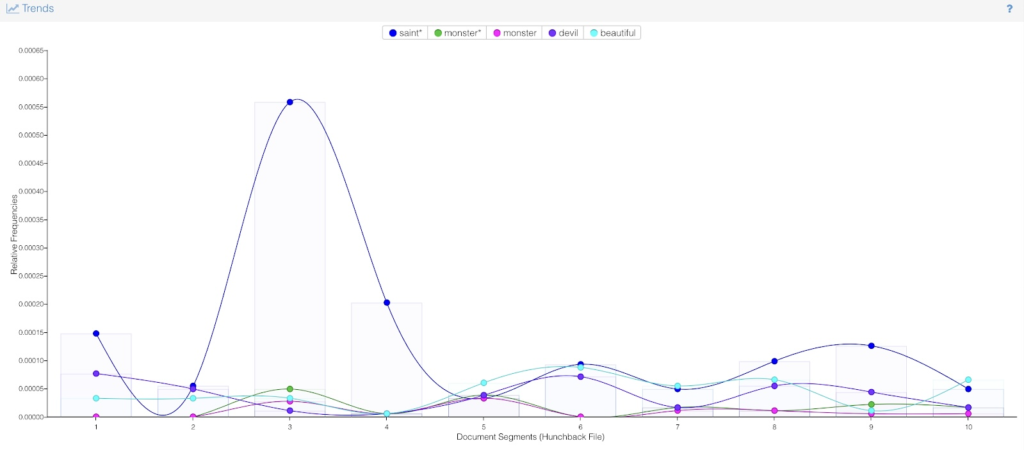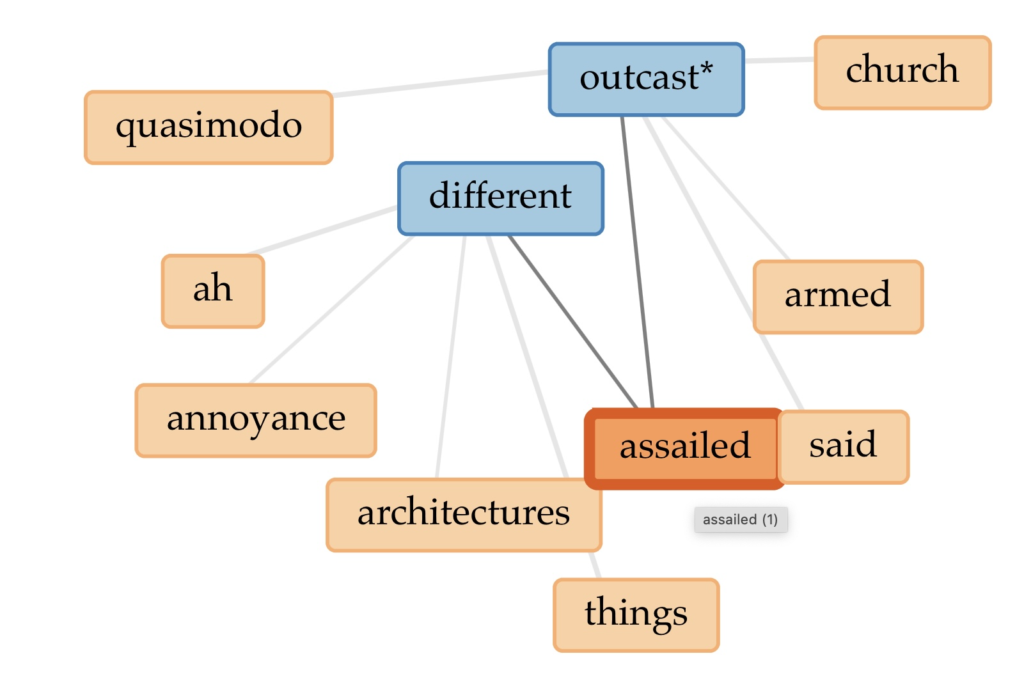
The corpus I have chosen for the text analysis assignment is Victor Hugo’s novel “The Hunchback of Notre Dame”.
The book depicts the story of Quasimodo, the deformed and isolated bell-ringer of Notre Dame Cathedral, and his cruel adopted father, Claude Frollo, the Archdeacon of Notre Dame. The abusive relationship between Frollo and Quasimodo comes to a head when they both develop an attraction to Romani street dancer, Esmeralda. While Quasimodo finds joy in falling in love with Esmeralda, despite knowing that his chances with her are slim, Frollo reacts with anger and vengeance towards his lust for her and his eventual rejection by her, which ultimately leads to her death. Frollo’s maltreatment of both Quasimodo and Esmeralda proves him to be evil and corrupt, yet the rest of society deems Quasimodo the monster because of his physical appearance. This raises an important question within the novel: What makes a monster and what makes a man?
This question, in the context of the novel, is explored in an online journal called “The Nobility of the Heart: Comparative study between the Creature in Frankenstein and Quasimodo in Notre Dame” written by Maciana Ribas Lladó. When discussing the fundamental differences between Frollo and Quasimodo as characters in comparison to how they are treated by society, it states that Quasi is “…A divine kid, he is pure, innocent and kind of childish in need of a parent, the goodness and hope is reflected in him, who despite of his physical aspect; prove to be more human than any other character in the story, thanks to his nobility which at the same time, counterpoises him with Frollo, basically due to his physic or “what the human eye perceives” (Lladó, 2019). This is supportive of how the novel warns readers of the consequences of judging a book by its cover and shares the theme that what appears “good” or “bad” on the outside is not an indication of who is good or bad on the inside.
For my project, I used the text analysis tool, Voyant, to explore if there were patterns within the language of the text that were reflective of the theme of the novel.
After uploading my corpus onto Voyant, the first thing I wanted to do was put the names of all five main characters into the trends section to see how they track throughout the novel. After getting a visualization of how often each character was mentioned throughout the book, I added the word “Monster” to see which character had the most/least overlap with the term. My result was the graph below:

I was shocked to find that the line representing “Quasimodo” had barely any overlap and was rarely in close proximity to the line representing “Monster”, except for in segment 7. This means that the word Quasimodo was rarely used in relation to the word monster. The two lines that overlapped with “Monster” the most were the ones representing “Frollo” and “Esmeralda”. The words “Esmeralda” and “Monster” being in close proximity, particularly in the middle and towards the end of the novel, is true to the plot, as she eventually is condemned for being a witch and a murderer (a false rumor created by Frollo as revenge for her rejection of him). However, it was interesting to see “Frollo” be so close to “Monster”. In fact, it seems that Frollo is the character most often mentioned in relation to the word “Monster”. This is supportive of the book’s message that Frollo was more of a monstrous character than Quasimodo or any of the other characters.
Next, I wanted to continue to find evidence within the text that Frollo was the real monster compared specifically to Quasimodo. To do this, I created two graphs in the Trends section again. In my first graph, I added the names “Frollo” and “Quasimodo” and just one other term “Malicious”, to get a simple view of which character was in closer relation to having bad intent throughout the course of the book. The results were once again supportive of the book’s theme. The line representing “Frollo” is incredibly close to the line representing “Monster” towards the end of the novel. So close, that in segments 8 and 10, they overlap nearly exactly. This is representative of the plot of the book because the novel doesn’t immediately establish that Frollo is a villain at the beginning; he’s presented as flawed but shows moments of kindness and potential for redemption, so it makes sense that “Frollo” is farther away from “Monster” at the start. It’s not until his treatment of Esmeralda and his work to get her hanged at the end of the novel that his true villainess is shown and the lines are incredibly close. It can also be seen that the line for “Quasimodo” does not intersect with “Malicious” at all, which is reflective of his character and his good nature. I, then, created another graph, only this time I added more words with a negative connotation (“Harm”, “Evil”, and “Misdeed”) to see how they tracked throughout the book compared to “Frollo” and “Quasimodo”. The results were the same.


Besides using the Trends section of Voyant, I was also very interested in using Topic Modeling to explore the book. For this, I used both the Topics section under Corpus Tools in Voyant and also the text analysis tool MALLET. While studying all of the different topics generated by both tools, I started to notice that there were several juxtaposing words in each group (more in Voyant than MALLET). For example, one of the groups MALLET generated is displayed below:
1 169.3558 sunlight ease weapons safe gaultière ink heap virtue port shrank calamity wear household sine bicêtre intersection examine spider resembles pen
This group was the second highest scored topic in one iteration of running MALLET with a score of 169.3558. Within the group you can see words like “safe” and “calamity” as well as “virtue” and “spider” (in the novel, the term “spider” is used symbolically for corrupt power, usually in contrast to “fly” which is symbolic of innocence and virtue). Another example of a group wit juxtaposing words, this time from Voyant, is as followed:
“Interrupted sanctuary eye moment trap felt hell movement angel”
Within this group, you can see words like “sanctuary” and “trap” as well as “hell” and “angel”. Specifically with “sanctuary” and “trap” the first thing that comes to mind is the Cathedral. Frollo repeatedly told Quasimodo that he needed to stay hidden in the Cathedral alone because it would keep him safe from the harshness of the outside world; in other words, the Cathedral would be his sanctuary. This paints Frollo in a more caring and positive light. But, as we know, not being allowed to leave the Cathedral led to Quasimodo feeling extremely entrapped and isolated in the building (more imprisoned than protected). This portrays Frollo in a much more menacing and villainous light. Hugo using these two juxtaposing words in the same way/context revealed that while something looked “good” at first glance, the sanctuary seemed like a positive and kind thing for Quasimodo, it was actually causing him pain. This relates to the theme of not judging a book by its cover. A similar observation can be made when looking at “hell'” and “angel”. Quasimodo viewed Esmeralda as heaven-like and the answer to all his prayers (as she was the first person to show him real kindness and he fell in love with her). However, Frollo related Esmeralda to hell as he was threatened by his attraction to her (being a man of faith) and eventually angered by her rejection of him.
I wanted to see if this is a pattern Hugo created of using juxtaposing words in closely-related contexts to reveal a disconnect between appearance and truth within the novel. The more I used Voyant, the more evidence I found that there is a pattern. For example, using the Correlations section in Voyant, I found that the word “love” is highly correlated to the word “damnation” with a score of 0.87221754. In addition, the word “sanctuary” is also highly correlated to “sacrifices” with a score of 0.9531427. Also, in the Collocates section, I found that the very first collocate of “desire” was “regret”. To confirm again, I went back to the Trends section and put in the contrasting terms “saint”, “devil”, “beautiful” and “monster”. The results are below:

As seen from the graph, despite the giant spike in the line representing “saint”, all lines are very close together and have a very similar shape. Interestingly, the two lines that overlap the most are “beautiful” and “devil” which may be a reference to how Frollo views Esmeralda.
A final interesting observation I found using the Link tool in Voyant, showed me that the words “Outcast” and “Different” had the word “Assailed” in common. This observation speaks to how society attacked and villainized anyone who was deemed different.

Both “outcast” and “different” are linked to “assailed” (meaning violent attack on). Hugo makes it clear that society (at least within the context of the novel) chooses to judge on appearance because of prejudice against those who are different or those who are deemed outcasts. It was easy (or easier) for Frollo to get respect as a powerful man of virtue worthy of respect and authority because he fits the mold of what society deems acceptable. Quasimodo and Esmeralda, because of his physical deformities and her race, are not deemed worthy of respect, thus easier to be believed as villainous or threatening. People fear the unknown/unrecognizable.
To conclude, yes, the tool helped me answer my question. It helped me to find a pattern of juxtaposition within the text that supports the book’s message that appearance on the outside is not an indication of what is on the inside. Did using the tool defamiliarize me with the text? I’d say no, not particularly, because while I was focused on analyzing literary techniques, word choice, and data, I was still viewing everything from the context of the plot. I did so in order to make connections that I might not have been able to if I did not know what the plot was. Though the two are not one hundred percent reliant on each other, framing all the data I found within the context of the plot helped me in my process.
Citations:
B, Anjana R, and Beena S Nair. Traversing Disability Stigma: Re-Presenting ‘Disability’ as a Form of ‘Identity’ in Victor Hugo’s the Hunchback of Notre- Dame. International Journal of Recent Technology and Engineering (IJRTE), 1 Nov. 2019, https://www.semanticscholar.org/paper/Traversing-Disability-Stigma%3A-Re-presenting-as-a-of-Hugo/2f4c734f0b3fae8045c31d55d8d1664128355f62.
Lladó, Maciana Ribas. The Nobility of the Heart: Comparative Study between the Creature in Frankenstein and Quasimodo in Notre Dame… Universitat De Les Illes Balears, June 2019, https://dspace.uib.es/xmlui/handle/11201/152849.